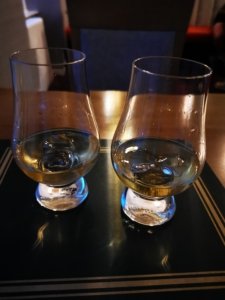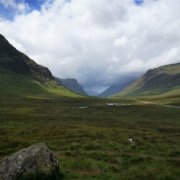Day Two
Miles Travelled: 173
We started our second day with a morning stroll to Ben Nevis. We were sorely tempted to climb it, but I hadn’t allowed for the seven to nine hour ascent and descent time on my spreadsheet, so instead we soaked up the energy and the scenery (as well as soaking up the rain!) 
We both decided we would return to climb it soon with our sense of adventure building. From Nevis we drove to the Black Isle (named maybe because of its soil or maybe because of the lack of snow on its hills or maybe neither!) and made our first official North Coast 500 stop at Fortrose. The intended first stop was Fortrose Cathedral but instead we found ourselves queuing for the car park at Chanonry Point at rising tide. A quick Google told me that rising tide was the perfect time to see dolphins there and unfortunately everyone else knew it. We learnt our first NC 500 lesson about car parks: they are small and often occupied by large motorhomes and campers. A twenty-minute queue around the already full car park got us in and out and back on the single-track road towards Fortrose and our original cathedral stop.
Fortrose Cathedral once served all the Highlands and today stands as a ruin. In contrast to the dolphin spotting, there were no other tourists with us – just two men cutting the grass. However, I would recommend it as a stop if you have time. The Cathedral is medieval in origin and once collected the income of thirty-one churches across the Highlands. It served as the burial place for nobles and clergymen, most notable being 400 years of Barons from the Munro Clan. Our trip to Fortrose was made complete by a stop in The Union Tavern, the warm and friendly local for warm and friendly locals, and the Cromarty Bakery. There were two bakeries in Fortrose and the first we came across had a big sign boasting it was Scotland’s Best Bakery. However, it had no produce left to sell not long after midday when we strolled past. The coffee and generous portions of cake we bought from the Cromarty Bakery were delicious compensation.
We decided not to return to Chanonry Point and dealt with the fact the dolphins would remain unseen – by us at least. It was a cold, wet, and windy day and if I were a dolphin I would have stayed at home! We moved onto the town of Cromarty and views over the Cromarty Firth. Here we saw the remnants of Scotland’s oil industry, the shadows of the former seaport, and the never forgotten footprints of the British Navy. Again, we didn’t see any other tourists; but I would strongly recommend a visit to you. Cromarty really touched a part of me. I made a mental note to read some of the work of the town’s most famous resident Victorian geologist and writer Hugh Miller. The sign starting his trail informed us ‘Cromarty still retains the atmosphere of that bygone age’ but I would argue that Cromarty retains the atmosphere of many bygone ages. The Emigration Stone of 2002 now looks as weathered and old as the 200-year-old ships whose names it bears. When you stand there looking out into the harbour you can almost hear the cheers (that sound like wails) of those setting sail to new lives in unknown places. I was starting to see the start of our North Coast 500 as a journey through the ages of Scotland. From cathedral clans to 20th century oil. I was excited by the next chapters of the story still waiting for us ….
From Cromarty we made some castle stops. The first was Tulloch Castle, just outside Dingwall, which is now a hotel and was once the home of my own clan. The hotel was still closed from Covid so we pulled up and out after a few snaps for me to remember my ancestral residence! The second stop at Dunrobin Castle is more conventional for the NC500 tourist. Although its origins are the Middle Ages, the impressive building and beautiful gardens we saw date from the mid-1800s. With 189 rooms, Dunrobin is the largest house in the North of Scotland and is in good condition. I must share that my most exciting find was the giant rhubarb or ‘dinosaur food’ in the garden! For those who know their stuff, the official name is gunnera manicata and I had to snap a photo straight away for my 8-year-old girl back home still obsessed with dinosaurs.
From Dunrobin to Wick and our stop for the night at Mackays Hotel. Another building that took us back to a bygone time when warmth and hospitality were the things that mattered most to guests tired and weary from their travels. In fact, many travellers would argue they still are! JD said it was like ‘staying at your Granny’s’: warm and cosy with a homecooked, locally sourced dinner and a dram of whisky to wash it down. I would happily stay in Mackays again and highly recommend both it and Wick to any NC500 traveller. Have the monkfish and the cheeseboard followed by Old Pulteney in the cocktail bar. You won’t regret it!
Upon returning home, we also discovered Wick is home to the world’s shortest street – Ebenezer Place – which also happens to be where Mackay’s No 1 Bistro restaurant is the only residence.











Leave a Reply
Want to join the discussion?Feel free to contribute!